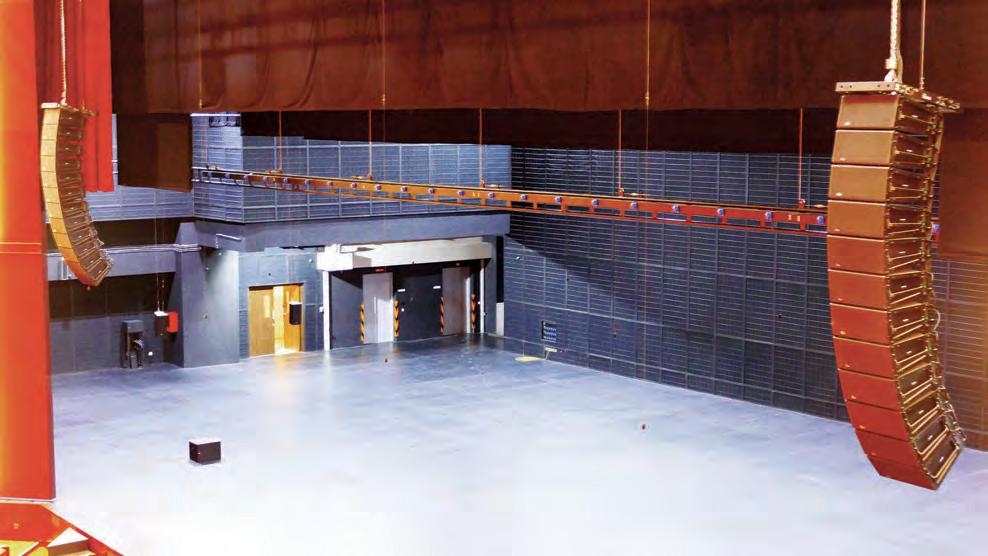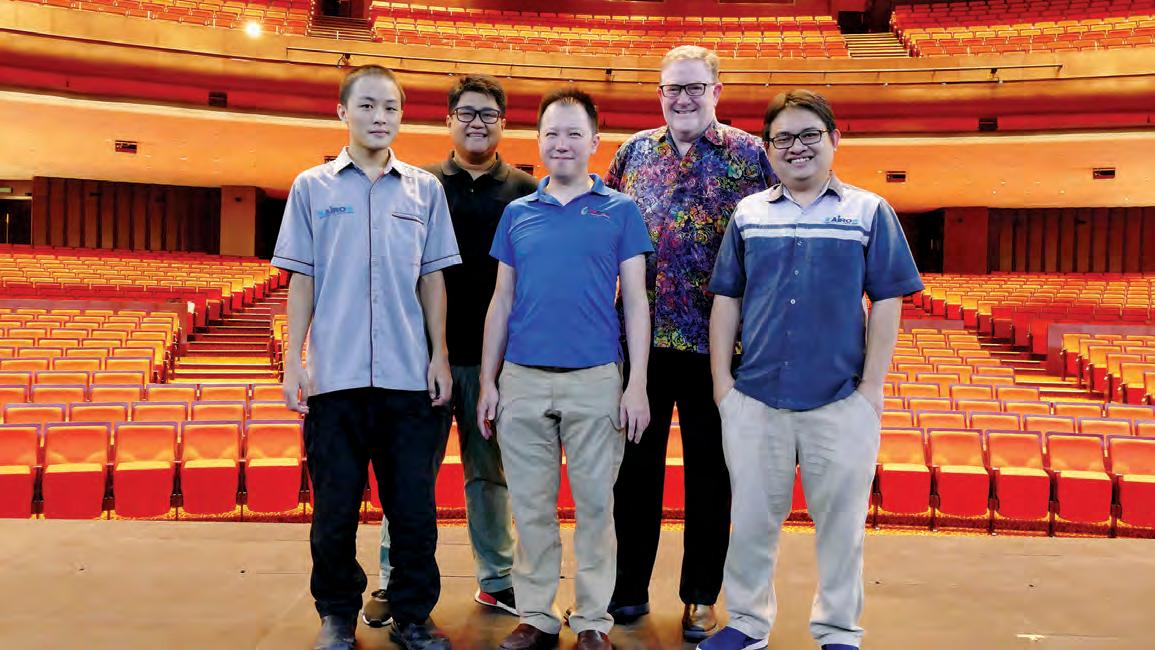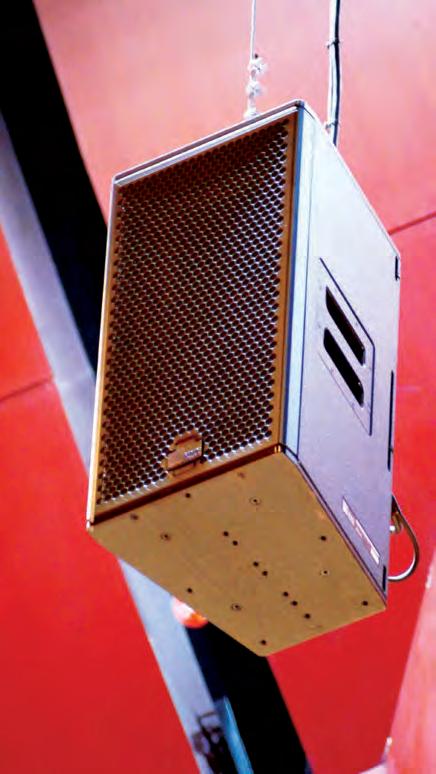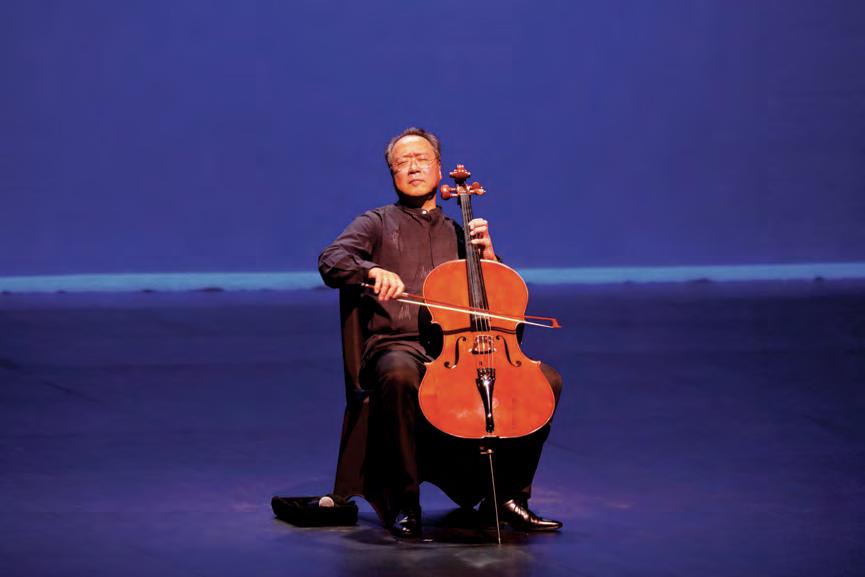
13 minute read
Big bang theory
A Meyer Sound Constellation acoustic system has raised the bar high for performing arts in Indonesia. Richard Lawn visits the new Jakarta International Expo Theatre
Opening in late 2019, the newly constructed theatre at the Jakarta International Expo (JIExpo) is currently the largest venue in Asia Pacific to be equipped with a Meyer Sound Constellation system. However, just 18 months prior to its opening, a serious blaze in the adjacent Niaga Building nearly ended the aspirations of supplier Mega Swara and systems integrator Kairos Multi Jaya.

The main PA comprises 12 Leopard arrays per side
As smoke spewed into the sky from the building, theatre owner Prajna Murdaya watched on as 18 fire trucks were deployed to control the fire. While his prayers were answered, the damaged building warranted extensive reconstruction. Having started to lay the AV and networking conduits and cabling throughout the theatre, Kairos Multi Jaya was forced to return to site three months later to repeat its original works. Both Mega Swara and Kairos Multi Jaya have teamed up before to breathe electro-acoustic energy into other notable theatrical landmarks in Jakarta.
Completed in 2015, the 1,300-seat Ciputra Artpreneur Theatre boasts an extensive Meyer Sound system comprising L-R Mica arrays, HP700 subwoofers and an extensive assortment of fills, including UPJ, UPA and UPM models. The Ciputra project drew several noted western experts together. Former associate director (operations) at the Hong Kong Academy for Performing Arts, Australian Philip Soden, was drafted in as the venue’s technical and operations consultant. He was joined by Jakarta resident and operations expert Bernard Grover, who actually heralds from the Lone Star State of Texas, bringing with him 45 years of theatre, film and television production experience.

L–R: Reyhan Dharma (Kairos Multi Jaya video engineer), Bayu Wicaksana (JIExpo Theatre technical manager), Leo Tanzil (Kairos Multi Jaya project manager), Bernard Grover (JIExpo Theatre GM) and Damaran Kristanto (Kairos Multi Jaya project manager)
At the request of the Berca Sportindo managing director Prajna Murdaya, the pair found themselves reunited for the JIExpo Theatre project. By his own admission, Grover was late to site when he took up the position of general manager in September 2019. “It is a little bit different when you are learning the setup rather than watching the system go in as you have planned,” he muses. “The size of the stage is on a par with Radio City Music Hall in New York. Although it can be trimmed back, the proscenium is in fact bigger, while the pit is one of the largest I have encountered. The auditorium design provides perfect sightlines from every seat, of which you can see all 2,500 when you stand at the rear wall of the stage.”
Every nuance in theatre design has been calculated in precise detail. The walls and ceiling have been meticulously designed for pristine acoustics, providing absorption and limiting acoustic transmissions. The air conditioning vents are located below the seats, and the steel frame of the stalls is isolated, further dampening the mechanical noise of the building. Devoid of rising columns and other structural obstructions, all seats located in the three-tiered auditorium offer clear sightlines of the 840m 2 performance area. With the removal of 41 seats, a 70m 2 pit can be hoisted to host a 50-piece orchestra, while other loading lifts expediate the load-in and load-out times of stage equipment to waiting trucks at the two dock bays. Behind the 11.5m x 29.5m (HxW) proscenium, the fully computerised fly bar system facilitates rapid scene changes at 1.5m per second from above the 26m-high grid.

Above: Galileo Galaxy 816 processors provide optimisation for the main Leopard array
Working closely with general contractor Total Bangun Persada Berca Buana Sakti and electrical contractor PT Skemanusa Consultama Teknik, Kairos Multi Jaya project manager Aurellia Faustina and site manager Damaran Kristanto realised that the team was up against the clock to fully complete their works. “I knew at the outset of this project that this theatre was taking Jakarta to another level, and not just in terms of scale,” he says. Called to site for a second time in September 2018, his team’s works included the implementation of the main loudspeaker and extensive back of house systems.

UPM-1P cabinets mounted into the stage lip
With acoustic design by international specialist WSDG, the venue can function as a multipurpose theatre, catering to all styles of music and performance. Serving the stalls and first-level balcony, the main PA comprises 12 Meyer Leopard arrays per side, while an additional set of four Leopards per side are dedicated to the upper-level balcony. The Leopard system is equipped with a Meyer RM server so that the AV operator can see the status of each speaker and monitor the system status in real time. UPQ loudspeakers provide centre-fill for the centre channel, while UPJ enclosures act as side-fills, UPM cabinets deliver both front- and underbalcony-fill and six 1100-LFC low-frequency control elements provide low-end reinforcement. Dual Galileo Galaxy 816 processors provide system optimisation for the selfpowered speakers.
Meyer Sound’s director of system optimisation, Bob McCarthy, provided the sound design using MAPP online, which highlighted the placement of all the individual selfpowered speaker models stipulated in the design. “The stage has variable widths between 18m and 30m and so the main systems have two different configurations to accommodate this,” reveals McCarthy, who spent five days at the theatre tuning and commissioning the PA. “The subwoofers are centrally located above the stage in a cardioid configuration, ensuring uniform LF coverage with very little leakage onto the stage.”

The venue’s rider-friendly credentials are furthered by twin SSL Live L550 digital consoles for monitor and main FOH mixing, receiving their inputs from ML 32.32 Dante stageboxes over the Dante network. “Prajna loves recording and has a passion for what he claims is the Rolls Royce brand of mixing consoles,” asserts Grover. “When combined with the Meyer speaker setup, this venue offers a totally unique setting for drama and musicals. Prajna is particularly impressed by the sonic richness and an almost analogue warmth quality. On the one hand, it’s natural and uncoloured but, on the other, there’s no requirement on our part for any further signal processing or for accessing plug-ins via MADI connectivity.” The rear control room is also home to a grandMA2 lighting control surface with 4,096 parameters and 648 dimmer circuits.
A Dante-enabled MediaMatrix Nion nE DSP platform serves as the backbone for back of house announcements and artist calls. The audio signals are routed through Powersoft Quattrocanali and Ottocanali 1204+4K4 amplifiers to zoned RCF PL 8X ceiling speakers. Providing user-friendly digital benefits for those working on-set and behind the scenes, a combination of 12 wired and eight wireless Clear-Com two-channel headsets are connected to a Helix MS-4X base station. Switchcraft Studiopatch 6425 patchbays connect analogue and digital I/O interfaces with DB-25 cables.
Given the notoriety of the city’s traffic, a digital signage system consisting of seven 43-inch displays has been integrated on all four levels of the theatre for latecomers. Live content captured on Datavideo PTZ PTC-200 cameras is routed to a Panasonic AW-HS50 video switcher via SDI before being output over the Cat-6a infrastructure. Just Add Power encoders and decoders enable the video-over-IP conversion, while live content captured on a Datavideo PTC-200 PTZ camera is routed to a Blackmagic Micro Converter before being output to the video-over-IP system. Just Add Power transmitters and receivers enable video distribution over the building’s network infrastructure.
Following a meeting with Kairos Multi Jaya’s Faustina, Prajna was compelled to experience Constellation prior to the audio installation. Based on digital Variable Room Acoustic System (VRAS) technology, Constellation is a network-based digital audio processing and distribution platform for configuration in sound reinforcement, show design and system control. His defining listening experience at the Singaporean American School coincided with a visit by John and Helen Meyer, who were touring the world as part of their Sonic Experience 50th anniversary. Prajna was astounded by how much Constellation could change the acoustics of a space to suit classical soloist, musical theatre, jazz and full rock concert scenarios at the touch of a button.

The L550 desks receive inputs from ML 32.32 Dante stageboxes
Despite the mitigating works of WSDG and Soden, the theatre provided some major challenges owing to its physical volume and considerable height. Designed by Meyer Sound acoustic engineer Jessica Borowski, the Constellation system was a mixed blessing for Kairos Multi Jaya. “Initially, this project comprised a PA and theatre package encompassing intercom, patching, lighting and other systems,” remembers Kristanto from when he first cast an eye over the schematic drawings and plans. “There was no discussion of a Constellation system at the outset, so Soden handled the redesign with input from Meyer Sound. I had to familiarise myself by studying new technical aspects on the Meyer Sound website, but ultimately this took us to a new level of expertise, and we had a lot of fun along the way.”
A distributed array of 51 miniature DPA cardioid and shotgun microphones capture the acoustic ambience from above the stage and audience seats. In between the microphones and loudspeaker output, a D-Mitri digital audio platform comprising 26 modules provides DSP and matrixing. The microphone inputs are routed from four D-Mitri audio input (DAI-24) interfaces over the proprietary Matrix Link Ethernet network to four D-Mitri Core Processors that host the VRAS algorithm.
The Constellation system is divided into six zones, each served by a DVRAS (Digital Variable Room Acoustic System) module containing unique measurement data and audio files used in system verification. A DCM-4 matrix mixing module mixes up to 288 busses of audio inputs before outputting the digitally enhanced signals to 10 D-Mitri Analog Out (DAO-24) units. Six Meyer Sound Netgear GS724Tv4 24-port network switches route the Cat-6 AVB, Cat-6 control, Cat-5e Matrix Link and redundant Cat-6 infrastructures.

A UPQ-2P provides centre-fill for the main PA
The Constellation outputs consist of 119 MM-4XP 4-inch flush-mounted wall loudspeakers, 22 UP-4XP ultra-compact enclosures, 48 Ashby-5c ceiling models, 20 UPM-1XP The L550 desks receive inputs from ML 32.32 Dante stageboxes
A UPQ-2P provides centre-fill for the main PA cabinets, 13 UP Junior-XP enclosures and 16 UMS-1XP compact subwoofers. Distributed throughout the venue in order to minimise cable runs, 30 MPS-488HP eight-channel power supplies route dedicated DC 48V and balanced audio signals to the 238 self-powered systems. Providing intelligent power control via the web interface, 12 Surge-X Axess Elite SX-AX16Ei IP-addressable power sequencers take up an additional 45U of space in the fourth-level comms room rack.
As the theatre project progressed, the exacting requirements of installing and deploying a Constellation system became evident to Kristanto’s colleague, Leo Tanzil. As the enormity of the team’s tasks dawned upon Tanzil, including the discovery that Constellation demands a Noise Criterion rating of NC20 prior to installation, sleepless nights followed. “Any noise that enters the room is immediately amplified by Constellation’s inherent reverberation and so no external noise can penetrate through,” he explains. “In addition to some lighting emissions, I discovered that the air conditioning was showing a reading of over NC40, so I was relieved when I found an abandoned kitten stuck in the air duct.”
As the kitten lost one of her nine lives, so Tanzil and Kristanto continued to lose sleep during the installation process. “We didn’t expect such a high degree of accuracy,” admits Tanzil. “Constellation demands perfection as the deployment of all the microphone drop lengths had to be exact to within 10mm. With such a tolerance, we initially made mistakes and wasted cable in the process, especially with some of those located above the stage.”

The Kairos Multi Jaya team installed 293 Meyer Sound speakers
Following SIM3 calculations, speaker placements were created. “The various ceiling and wall-mounted speakers also needed to be installed in the exact locations,” explains Kristanto. “The speakers had to be angled at a specific inclination without compromise and the locations could not deviate more than 100mm from the plans, despite obstacles such as fire sprinklers and lighting. Each one of the 119 MM-4XP models, for example, required a 20mm gap around it and a layer of rockwool at the rear to ensure no resonance. In terms of power supplies, none of the 238 speakers could be run in parallel and many of the cable runs to the technical room for terminating to the power supplies were well over 100m, so they needed to be split into two locations.”
Once installed, all the speakers and microphones had to be individually matched, calibrated and voiced. Silence was required, so the presence of other contractors completing their construction works provided another obstacle for the installation team. As a result, Prajna arranged for the contractors to complete their work at night over an 11-day period, ensuring the Constellation acoustics team could finish their intensive works on schedule.
“Meyer demanded no ground noise, so other contractors such as cleaners were prohibited entry and there could be no talking during voicing,” adds Kristanto. “In addition to referencing the outputs using pink noise, Meyer’s John Pellowe tuned the Constellation system with his own voice by reading a magazine article, shouting and walking all over the theatre and stage. He also created several room presets which can be applied on the Constellation system. Each speaker had already been tuned by Meyer Sound’s senior constellation specialist, Tom Cavnar, during Meyer’s first visit to the site. The room becomes so dry that you can hear footsteps from a distance, so we could not have any interruptions. Naturally, any little problem with the speaker is very noticeable, and checking was required. By accessing the web programme using wireless iPad control, we could identify any speaker with problems.”
Like the rescued kitten, Grover found himself purring upon listening to the fully commissioned audio systems. “The acoustic profile is about as close to perfect as anywhere I have been,” he declares. “When you combine the Meyer Leopard system with Constellation, you get an audio experience that is not only unequalled in Indonesia, it challenges anything in Asia. That is a big claim I know, but it stands up to scrutiny.”

Yo-Yo Ma’s first-ever concert in Indonesia was enhanced by Constellation
Nerves built prior to the inaugural performance for the JIExpo Theatre – Yo-Yo Ma’s first-ever concert in Indonesia in early December 2019, with the multiple Grammy Award-winning cellist performing Bach’s Six Cello Suites. Although the rider stipulated just two pairs of microphones and a loudspeaker system to amplify his cello, Grover decided to test the
Constellation system during the soundcheck. “Upon hearing, his team made the decision to proceed with the performance completely unamplified,” says Grover.

As arriving guests sat down to witness Yo-Yo Ma’s genius from unrestricted seat views, they were unaware of the significance the audio system would play in the performance. “Despite being sat on the upper balcony some 25m away from Yo-Yo, it felt as if I was standing next to the artist,” continues Grover. “Constellation’s passive amplification was perfect as there was absolutely no sense of audio directionality or delays, and I could hear every minute detail of his fingering and bowing. At the end of the first movement on the second suite, there is a single note he holds for four measures with a small fade. This was audible to the moment he took the bow off the string. Impressed isn’t even the word for it in my 46 years of professionalism – I was emotionally moved.”
By bringing Yo-Yo Ma to Jakarta, Grover and the team are persuading more local and international artists to perform at the unique venue. “With Constellation, we don’t need to mic every single individual onstage or set up shotguns for an acapella choir, for example,” he says. This is down to profiles and presets within the D-Mitri software set up by the Meyer Sound engineers, allowing theatre technicians to adjust the warmth, strength and brightness characteristics of the reverberation envelope.

SSL Live L550 digital consoles handle monitor and FOH mixing
“The acoustic sound profiles that are built into it offer the right atmosphere for a choir, symphony, a musical, a rock band or whatever you want – and that’s what makes this venue unique,” concludes Grover. “The look and feel of the venue create a wow effect upon entry. By fine-tuning the audio experience to whatever arts performance you want to bring in here, the audience will be in awe. Once you have experienced Constellation, you don’t want to listen to a traditional loudspeaker system again.”







